1. Introduction: The CEO’s Warning That Shook the Tech World
When a CEO of Satya Nadella’s stature admits that AI could destroy Microsoft, the tech world listens. His statement isn’t just a caution—it’s a rare confession from one of the most powerful executives in Silicon Valley.
For decades, Microsoft has defined how the world works, plays, and communicates. From Windows to Office and Azure, the company shaped digital life for billions. But Nadella’s latest warning paints a darker picture—one where artificial intelligence doesn’t just empower Microsoft but possibly replaces it.
The question now is simple yet chilling:
Can the technology Microsoft helped build also lead to its downfall?
2. The Context: Why Nadella’s Words Matter
Satya Nadella’s fear didn’t come from nowhere. Microsoft’s dominance has always rested on control—control of software, operating systems, and productivity tools. But in the AI era, that control is slipping.
For 40 years, people relied on Windows PCs and Microsoft software. But AI is changing how users interact with technology. Instead of opening apps, users now talk directly to intelligent systems that can generate, predict, and execute tasks instantly.
That’s why Nadella’s mention of DEC (Digital Equipment Corporation) is so haunting. DEC was once a leader in computing, yet it vanished because it couldn’t adapt fast enough to a changing market. Nadella knows that even the strongest empires fall when they fail to evolve.
Microsoft has the money, talent, and reach—but AI doesn’t care about history. It only rewards innovation and adaptability.
3. The Threat: How AI Could Undermine Microsoft’s Core
The danger Nadella points to isn’t theoretical—it’s already happening.
AI platforms like ChatGPT and Claude are replacing tasks once done in Word, Excel, and PowerPoint. Why create slides manually when an AI can do it in seconds? Why use traditional search engines when AI copilots can summarize the web for you?
Even Windows, Microsoft’s crown jewel, faces an identity crisis. As devices and operating systems merge into AI-driven interfaces, the importance of Windows may fade. People no longer care what platform they’re on—only that the AI assistant gets things done.
This shift could render Microsoft’s foundational products irrelevant in just a few years.
Nadella’s biggest fear isn’t competition—it’s irrelevance. And in tech, irrelevance is death.
4. Microsoft’s Gamble: Betting Everything on AI
To avoid becoming obsolete, Microsoft is going all-in on AI. The company has integrated Copilot into Windows, Office, and even GitHub. It also invested billions in OpenAI, the creator of ChatGPT, giving it a front-row seat in the AI revolution.
But this strategy is a gamble—and Nadella knows it.
By relying so heavily on OpenAI, Microsoft risks becoming dependent on an external partner that it doesn’t fully control. The infrastructure costs for AI are massive, and the returns aren’t guaranteed.
In business terms, it’s like walking a tightrope between dominance and disaster.
Microsoft’s AI-first approach has also created internal disruption. Engineers, marketers, and product teams must rethink everything—from software interfaces to business models. The company is essentially rebuilding itself in real-time, and that comes with risks.
A fractional CTO working with a startup might see this as a bold but dangerous move. It’s like reinventing a plane while it’s still in flight. The speed of innovation is breathtaking, but one wrong move could bring everything crashing down.
Still, Nadella isn’t running from the challenge. His goal is clear: make AI the new Windows—an indispensable layer that powers every part of modern life.
5. Lessons from DEC: History’s Warning for Microsoft
When Nadella referenced Digital Equipment Corporation (DEC), it wasn’t random. It was a warning drawn from tech history.
In the 1980s, DEC was a titan. Its computers ran universities, governments, and corporations. But as the market shifted toward personal computers, DEC ignored the change. It kept building mainframes while smaller, faster, cheaper PCs took over.
Sound familiar?
Microsoft risks a similar fate if it clings too tightly to legacy products like Windows and Office instead of embracing the future fully. The difference is that Nadella sees the threat coming. He’s not waiting for AI to disrupt Microsoft—he’s trying to lead the disruption himself.
But history shows that even visionary leaders can lose control when the pace of change becomes overwhelming.
To survive, Microsoft must become more agile, more open, and more innovative than ever before.
6. The Future: Can Microsoft Survive Its Own AI Revolution?
So what happens next?
Microsoft’s survival depends on how well it balances innovation and stability. The company must lead the AI wave without letting it wash away its core identity.
Here’s what that means:
- AI Integration, Not Replacement: Microsoft needs to ensure AI enhances its products rather than replaces them. Users still want control, not just automation.
- Ethical AI Leadership: As one of the most influential companies in the world, Microsoft must prioritize transparency, data privacy, and fairness.
- Business Model Reinvention: The era of one-time software purchases is over. Subscription models and AI-as-a-service will define the next decade.
- Open Ecosystems: Microsoft must keep partnering with startups, developers, and even competitors to stay ahead of innovation.
Nadella’s strategy might look risky, but it’s grounded in logic: the only way to survive disruption is to be the disruptor.
The rise of fractional CTOs in startups and mid-sized companies mirrors this approach. These experts don’t just manage tech—they future-proof businesses. They focus on adaptability, just as Nadella is doing at a global scale.
In that sense, Microsoft’s journey is a case study in survival. It’s a battle between legacy and leadership, between comfort and change.

7. Conclusion: A Bold CEO in the Age of Uncertainty
Satya Nadella’s warning that AI could destroy Microsoft isn’t a statement of fear—it’s a statement of awareness. It shows that even the world’s biggest companies must evolve or face extinction.
Nadella knows that the future won’t be decided by who has the most users, but by who uses AI most intelligently. He understands that AI isn’t just another wave—it’s a tsunami that can either drown or elevate those who face it.
The irony is powerful: Microsoft, once the disruptor, now fights not to be disrupted.
But if history has taught us anything, it’s that adaptability wins. Whether it’s startups guided by visionary founders or enterprises led by CEOs with courage, the future belongs to those who dare to change before they’re forced to.
At its core, this story isn’t about fear—it’s about transformation. Nadella isn’t predicting Microsoft’s end; he’s preparing for its rebirth.
And as we analyze this bold chapter in tech history, one thing is certain: the line between innovation and extinction has never been thinner.
At StartupHakk, we believe that this moment defines the next generation of leaders—the ones who can face disruption not with fear, but with strategy, adaptability, and relentless vision.




